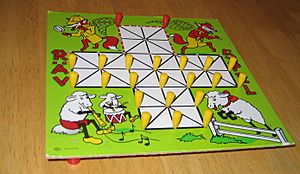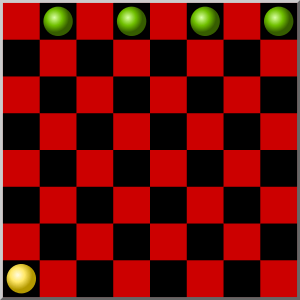Fox games facts for kids
Fox games are a type of board game for two players. They are called 'asymmetric' because each player has a different goal. One player controls the 'fox' (or 'wolves' or 'leopards') and tries to capture the other player's pieces. The other player controls the 'geese' (or 'sheep' or 'hounds') and tries to trap the fox or reach a safe spot.
There are many versions of these games around the world. Some examples include Fox and Geese in Britain, Renard et les poules in France, Lupo e pecore in Italy, Fuchs und Gänse in Germany, Schaap en wolf in the Netherlands, riebantablu in Sápmi, Rävspel in Sweden, Refskák in Iceland, Vlci a ovce in Slovakia, Volk i ovtsy in Russia, and Bagh-Chal in Nepal.
Contents
Halatafl: The Tail Board Game
Halatafl is an old game from Scandinavia. Its name means 'tail board' in Old Norse, probably because of a fox's tail. In Sweden, a similar game called rävspelet (which means 'the Fox game') is still played using holes and pegs.
In Halatafl, there are two fox pieces and 20 sheep pieces. The sheep player's goal is to get their sheep to a special area on the board called the 'paddock'. The fox player's goal is to stop the sheep from reaching this area.
The fox pieces start in the corners of the paddock. The sheep pieces start on the opposite side of the board. Players take turns moving one piece at a time. Sheep can only move forward or sideways. Foxes can move in any direction, even backwards.
If a sheep piece is next to an empty spot, and a fox piece can jump over it to that empty spot, the fox must jump and capture the sheep. This is like how pieces are captured in checkers. If a fox can make multiple jumps in one turn, it must do so. The sheep win if they manage to fill the paddock with their pieces.
Fox and Geese: A Simpler Version
In English-speaking countries, a simpler game called Fox and Geese is very popular. In this version, the goal is not to reach a specific spot. Instead, it's all about capturing pieces or trapping the fox.
The game starts with one fox piece in the middle of the board. Thirteen geese pieces are placed on one side of the board. Both the fox and geese can move to any empty space next to them, even diagonally.
The fox can jump over geese pieces to capture them, just like in checkers. If the fox can make several jumps in one turn, it can do so. However, unlike Halatafl, the fox does not have to capture a goose if it can. The geese cannot jump over pieces.
The geese win if they surround the fox so it cannot move anymore. The fox wins if it captures enough geese so that the remaining geese cannot trap it. The traditional game with 13 geese often gives the fox an advantage. Because of this, some versions use more geese, like 15, 17, or 18, or even two foxes, to make the game more balanced.
Fox and Hounds: On a Chessboard
This game is also known as "Wolf and Sheep" or "Hounds and Hare." It is played on a standard 8x8 chess or checkers board. Only the dark squares of the board are used.
Four 'hounds' pieces start on the dark squares along one edge of the board. The 'fox' piece starts on any dark square on the opposite edge. The fox's goal is to cross the board and reach any of the squares where the hounds started. The hounds' goal is to stop the fox from doing this.
The hounds move like a draughts man, which means they move one square diagonally forward. The fox moves like a draughts king, meaning it can move one square diagonally forward or backward. In this game, there is no jumping over pieces, and no pieces are removed from the board.
Players take turns moving one piece, with the fox moving first. The player controlling the hounds can only move one hound per turn. The fox is trapped if it cannot move to any empty square. For example, two hounds can trap the fox against the edge of the board.
Koti Keliya: The Leopard Game
Koti Keliya or the Leopard Game is a game similar to Fox and Hounds. It was played in Sri Lanka. This game uses a large 12x12 checkered board, which is often red and white.
One player controls a single 'leopard' piece. The other player controls six 'cattle' or 'dog' pieces. The cattle pieces start on the white squares of their first row. The leopard can start on any empty white square.
Both the leopard and cattle pieces can only move diagonally. The cattle can only move one space diagonally forward onto an empty square. The leopard can move one or two spaces in any diagonal direction, as long as the squares are empty.
The cattle's goal is to trap the leopard so it cannot move. The leopard's goal is to get past the cattle, preventing them from trapping it. There is no capturing of pieces in this game.



